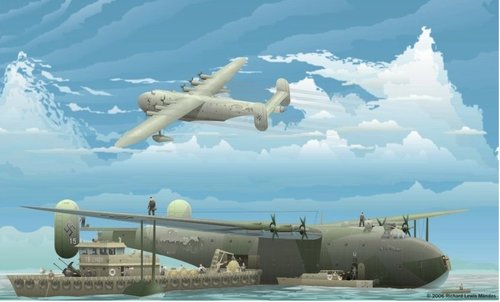- Joined
- 14 June 2006
- Messages
- 2,297
- Reaction score
- 480
Lufhansa held two successive competiton for the supply of trans-atlantic airliner. First was in June 1937, a month or so after the Hindemburgh "accident" (really thje competitons terms were in preparation since at least the beginning of 1936 and the perspective probably suppliers knew this, Dornier almost surely; Goering was opposed to the airships and simply waited until aeronautical engeneering could produce aircraft capabel to rival the Zeppelins). On this competiton another topic.
In 1938 Lufthansa held another competiton, for Trans-atlantic airliners. Solid information is scant, but it seems that there were two specifications: one for a North-Atlantic airliner, with a take-off weight in the order of 140 metric tons, and one for the South-Atlantic route, with a take-off weight in the 70-ton class. Or it could be there were two classes, both able to fly the different routes. Anyway, all the companies involved answered with Flugbooten, with the exception of Focke-Wulf, which offered its Trans-Ozean. Since I've already covered the TO in another topic, I'll examine here the Flugbooten proposals. Companies that answered one or both the specifications were (AFAIK):
Dornier - 140 and 79 ton
Hamburger Flugzebau (later Blohm U. Voss) 70 ton
Heinkel 70 ton
Weseflug 140 and 70 ton
I haven't be able to find any Junkers proposal. The 1938 land based (a sort of scaled-up Ju-52 with double-deck) EFo 21 could have been a candidate, but since is known that only he FW was land-based, I'd exclude it. Efo-21 would have been in the 70-ton class. The 1939 EF-53 was a four-engines trans'atlantic airliner, a forerunner of the later EF-100, but this too wasn't officially tendered to Lufthansa. There were spare RLM Junkers assigned numbers from Ju-91 to Ju-94, not used except possibly the J-92, an experimental four-engine bomber and troop transport (probably an evolution of Ju-90?).
In 1938 Lufthansa held another competiton, for Trans-atlantic airliners. Solid information is scant, but it seems that there were two specifications: one for a North-Atlantic airliner, with a take-off weight in the order of 140 metric tons, and one for the South-Atlantic route, with a take-off weight in the 70-ton class. Or it could be there were two classes, both able to fly the different routes. Anyway, all the companies involved answered with Flugbooten, with the exception of Focke-Wulf, which offered its Trans-Ozean. Since I've already covered the TO in another topic, I'll examine here the Flugbooten proposals. Companies that answered one or both the specifications were (AFAIK):
Dornier - 140 and 79 ton
Hamburger Flugzebau (later Blohm U. Voss) 70 ton
Heinkel 70 ton
Weseflug 140 and 70 ton
I haven't be able to find any Junkers proposal. The 1938 land based (a sort of scaled-up Ju-52 with double-deck) EFo 21 could have been a candidate, but since is known that only he FW was land-based, I'd exclude it. Efo-21 would have been in the 70-ton class. The 1939 EF-53 was a four-engines trans'atlantic airliner, a forerunner of the later EF-100, but this too wasn't officially tendered to Lufthansa. There were spare RLM Junkers assigned numbers from Ju-91 to Ju-94, not used except possibly the J-92, an experimental four-engine bomber and troop transport (probably an evolution of Ju-90?).






